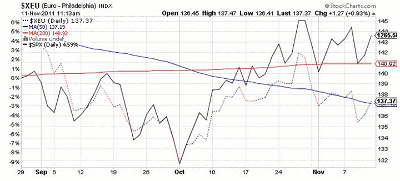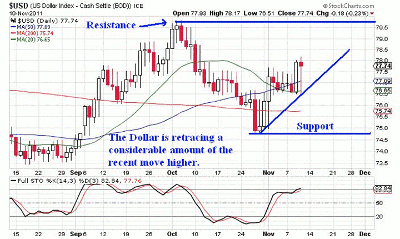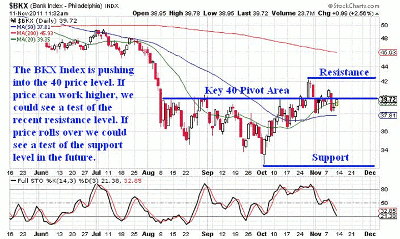Controlling risk and trading smaller position sizes is crucial, says trader JW Jones, who defines the key price levels to watch on the S&P 500 and other market-moving indicators such as EUR/USD and the KBW Banking Index.
At the beginning of last week, I warned a few fellow traders that the market was extremely overbought and that a top could be forming. While it is still unclear whether a major top has formed, it is without question that we saw a major correction last Wednesday, as yields on Italian debt caused margin-requirement adjustments at the London Clearing House.
My current view on the S&P 500 is neutral. I am watching several key price levels on the S&P 500 Index for clarity, but so far, Mr. Market has not tipped his hand. I am watching for a breakout over recent highs around the 1,290 area before I consider layering back into long positions.
Consequently, I am watching the 1,230 and 1,190 areas as potential short entry points. The daily chart of the S&P 500 Index is shown below:
Clearly, the 1,190-1,200 level should offer strong support, as the 50-period moving average is resting right at the 1,200 price level currently. If the 1,190 price level breaks down, I think we could see a dramatic selloff transpire.
On the flip side, if the recent highs around 1,290 are taken out to the upside, we could see a rally that takes us back to the 2011 highs around 1,370. Right now, I am going to wait patiently and let others do the heavy lifting.
The 1,257 price level on the S&P 500 Index is a major pivot that I am going to be watching closely. If the bulls can push prices above that area for two or more consecutive closes, I think the bulls may have the bears on the ropes.
NEXT: See Key 1,257 Price Level in Focus
|pagebreak|At the time of writing, SPX is currently trading around the 1,263 level. If the bulls can hold up prices into the closing bell, we could see an extension higher. The below chart of SPX illustrates the key 1,257 price level:
At the close last Tuesday (Nov. 8), I was involved in an SPY 122 put calendar spread for members, which capitalized on time decay (Theta) as well as lower prices in the Spyder Trust (SPY).
Thursday morning, I took profits on the position, locking in a gain of around 13% on maximum risk. Recently, I have had several winning trades for members of my service, but I admittedly have been taking profits aggressively and trading in smaller size due to the wild volatility swings that are commonplace in this market.
Trading is a marathon, not a sprint, and my focus is to live to play another day. Since the inception of my service, I am running at about a 70% success rate based on all trades that have been taken. I am not telling you this to boast, I am telling you this to point out that I am wrong 30% of the time.
In the trading world, the overall numbers look good, but if my position sizing is not appropriate, the 30% could potentially blow up my account.
With that in the back of my crowded mind, I try to use smaller position sizes and lock in profits aggressively during times of widespread volatility. I take fewer trades and focus my attention on risk and money management during times of heightened volatility, which has been prevalent the past few weeks.
See related: What Not to Do in Volatile Markets
In addition to monitoring my risk profile, I am watching the price action in two underlying assets which I believe will throw off clues about where this market may be headed.
NEXT: EUR/USD Is a Valuable Market Indicator
|pagebreak|The EUR/USD currency pair has been on my screens quite a bit the past few weeks. Most of the time, I monitor the US dollar index futures as well, but recently, my focus has been on the EUR/USD currency pair instead.
The chart below illustrates the correlation between the euro currency and the S&P 500 since September:
Since the beginning of September, the moves in the S&P 500 have been very similarly correlated to the euro currency, as can be seen above. Additionally, the Dow Jones Industrial Average also has very similar congruence in terms of price action when compared to the euro.
The strength of the euro has a profound impact on the price action of the US dollar index. The US dollar index soared on Wednesday and took out recent resistance. Since Wednesday, the dollar has been retracing a large portion of the move higher. The daily chart of the dollar index is shown below:
It is a bit too early to tell for sure, but the dollar could be rolling over based on austerity plans coming out of Italy and the expectation that the Eurozone is going to try to get ahead of the crisis unfolding based on the yields of Italian government debt instruments.
Last and certainly not least is the banking sector of the economy. The KBW Banking Index (BKX) is a proxy for financial institutions domestically. The KBW Banking Index is a great indicator for the future price action in the S&P 500. Stocks cannot rally if the banks do not participate with higher prices.
If stocks are selling off and the financials are holding up well, many times equity indices will reverse higher. The key price level that a lot of traders are monitoring currently is the 40 area. The daily chart of the KBW Banking Index is shown below:
Similar to the key 1,257 pivot level on the S&P 500 Index, the key 40 price level on the KBW Banking Index has a similar impact on the underlying price action. If the bulls can push the BKX above the 40 price level and hold it up then a rally in stocks becomes more likely.
As I write this, BKX is trading at $39.78 per share, so we are getting close to crunch time. The S&P 500 has broken above its pivot during intraday trade, and now a lot of eyes are watching to see if the banks can follow through.
Ultimately, investors could be looking at a Santa Claus rally or an absolutely ugly selloff in the near future. I will be monitoring the key price levels mentioned above on the S&P 500 and will wait patiently for Mr. Market to tip his hand.
This is a tough market to trade, and volatility is running relatively high. Headline risk coming out of Europe is seemingly constant. I would keep position sizes light and monitor risk aggressively. This is not the time to be a hero!
By JW Jones of Options Trading Signals.
Subscribers to the OTS service have pocketed some serious return in the past few months. If you’d like to stay ahead of the market using my low-risk option strategies and trades, check out OTS here and take advantage of my professional trading alerts and position-management experience each week.























